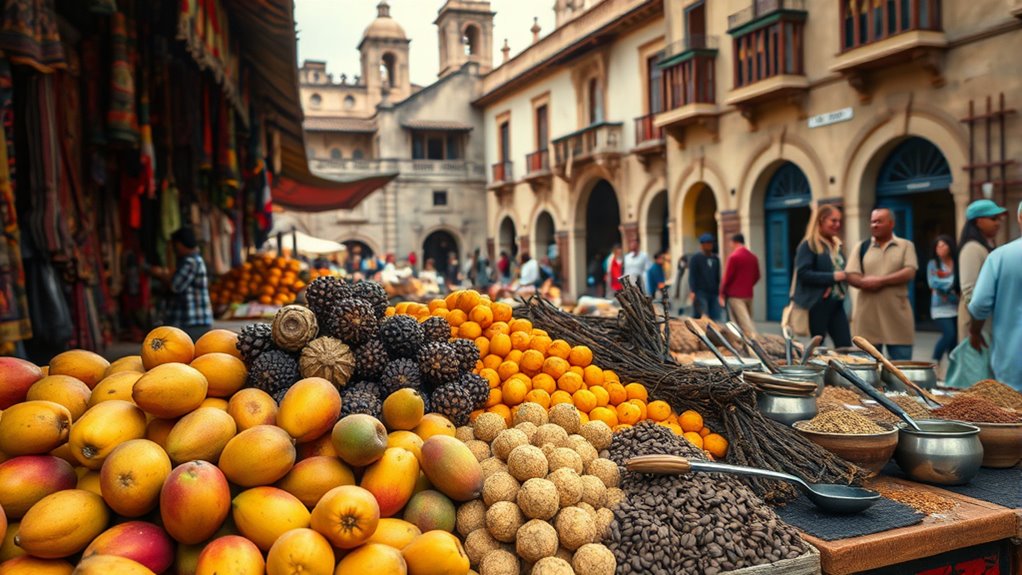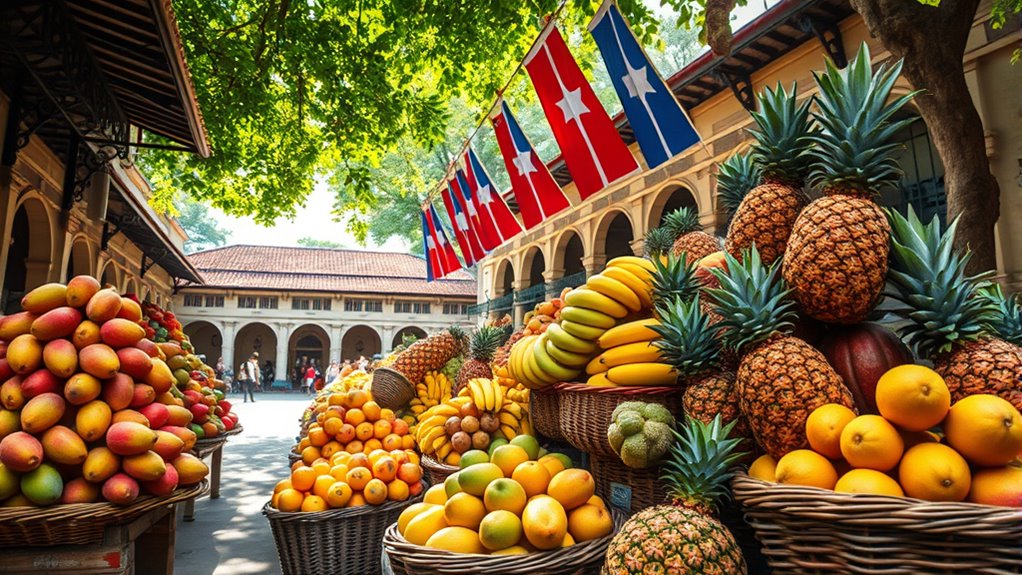Colonization transformed your eating habits by introducing Western foods, crops, and ways of cooking that became part of many cultures worldwide. You now find ingredients like wheat, sugar, and dairy in traditional dishes that once used local products. Trade routes brought spices, coffee, and canned goods, blending cuisines and expanding your options. This legacy still influences what you eat today, and exploring further reveals even more about how colonization shaped your food choices.
Key Takeaways
- Colonization introduced Western dietary patterns, embedding ingredients like wheat, sugar, and dairy into local cuisines.
- New crops and livestock from colonization transformed traditional diets, making sugar, wheat, and exotic ingredients staples.
- Trade routes enabled the global exchange of foods like spices, coffee, and canned goods, influencing local eating habits.
- Colonial focus on cash crops shifted agricultural practices, impacting food diversity and reliance on imported products.
- The legacy of colonization persists through hybrid cuisines and the integration of Western ingredients into daily routines worldwide.

Colonization has profoundly shaped the way people around the world eat today, often embedding Western dietary patterns into diverse cultures. When European powers expanded their territories, they brought with them not just political control but also new foods, farming techniques, and eating habits. As a result, many local cuisines began to incorporate ingredients like wheat, sugar, and dairy, which were previously less common or unfamiliar. You might notice that many traditional dishes now feature bread or pastries, reflecting colonial influence. These changes didn’t happen overnight but gradually transformed local diets, often making them more similar to Western patterns.
During colonization, the introduction of new crops and livestock played a significant role in reshaping diets. For example, sugar plantations in the Caribbean and parts of Asia led to increased consumption of sweetened foods and beverages across the globe. Sugar became a staple in many households, influencing everything from desserts to drinks.
Similarly, the cultivation of wheat in regions that previously relied on indigenous grains changed the staple foods, replacing traditional staples with bread and pasta. You may find that these ingredients, once considered exotic or luxury items, are now everyday essentials in many countries.
Colonization also established new trade routes that facilitated the global exchange of food products. Spices from Asia, coffee from Africa, and canned goods from Europe became available worldwide, altering local eating habits and food preparation methods. These imported items often became integrated into traditional recipes, creating hybrid cuisines.
For instance, many countries adopted coffee as a daily beverage, a practice introduced through colonial trade networks. You might notice how breakfast routines or social gatherings are now centered around coffee or tea, both products deeply tied to colonial history.
Furthermore, colonization influenced food production and consumption patterns driven by economic motives. Colonial powers often prioritized the cultivation of cash crops like cocoa, tea, and rubber, which fueled global markets but sometimes at the expense of local food security.
This focus on export crops meant that indigenous communities shifted away from subsistence farming to grow commodities for export, impacting local diets and food diversity. You might observe that certain regions rely heavily on imported foods, which can sometimes lead to nutritional challenges or loss of traditional food practices.
Additionally, colonial infrastructure such as railways and ports played a crucial role in accelerating the distribution of these food products, making them more accessible worldwide.
In essence, colonization’s legacy in food history is complex and lasting. It has created a world where Western-inspired ingredients and dishes are widespread, blending with local flavors and customs. When you eat today, you’re often experiencing a fusion of indigenous traditions and colonial influences, a testament to centuries of shared history and cultural exchange.
This ongoing evolution underscores how deeply colonization has woven itself into the fabric of global eating habits, shaping what and how you eat in ways you mightn’t always realize.
Frequently Asked Questions
How Did Colonization Influence Traditional Local Cuisines?
Colonization deeply influenced local cuisines by introducing new ingredients, cooking techniques, and food practices. You might notice dishes now feature ingredients brought from colonizers’ homelands, blending native and imported flavors.
Colonizers also reshaped food production, trade, and consumption patterns, often prioritizing export crops. This fusion created unique culinary identities, but also led to the loss of some traditional foods.
Which Colonizing Countries Had the Biggest Impact on Global Diets?
You see, the colonizing countries with the biggest impact on global diets include Britain, Spain, Portugal, France, and the Netherlands. They introduced new ingredients, cooking styles, and food practices across continents, transforming local cuisines.
These nations spread staples like potatoes, maize, and sugar, shaping eating habits worldwide. Their influence persists today, as many popular foods and culinary traditions owe their origins to these colonial powers’ extensive reach and cultural exchanges.
Are There Remnants of Colonial Food Practices in Modern Eating Habits?
You can still see remnants of colonial food practices in your modern eating habits, like enjoying coffee, tea, and sugar, which were introduced by colonial powers.
Many countries incorporate foods and cooking styles that originated during colonization, such as spices, tropical fruits, and processed foods.
These influences shape what you eat daily, reflecting a blend of local traditions and colonial legacies that continue to impact global diets today.
How Did Colonization Affect Agriculture and Food Production Systems?
Colonization transformed agriculture and food production systems by introducing new crops, farming techniques, and resource exploitation.
You might notice how colonial powers prioritized cash crops like sugar, coffee, and cotton, often at the expense of local food security. These practices led to monocultures and environmental impacts.
Today, you see the lasting effects in global food markets, with certain crops dominating and local farming traditions often marginalized, shaping what and how you eat.
Did Colonization Lead to the Spread of Specific Food Ingredients Worldwide?
You see, colonization definitely led to the spread of specific food ingredients worldwide. As colonizers traveled, they brought crops like potatoes, tomatoes, and maize to new regions, transforming local diets.
These ingredients thrived in different climates, becoming staples in many countries. This exchange changed what people eat daily, creating a global food landscape that’s rich and diverse, driven largely by the movement of ingredients during colonization.
Conclusion
Imagine your plate as a tapestry woven from stories of explorers and empires, each thread representing a taste borrowed across oceans. As you savor your meal, remember you’re part of this ongoing journey—an intricate dance of cultures and histories. Colonization, like a river carving new paths, has shaped what we eat today. Embrace this mosaic, knowing your choices honor or challenge these deep-rooted roots, shaping a future where everyone’s flavor can be truly their own.









